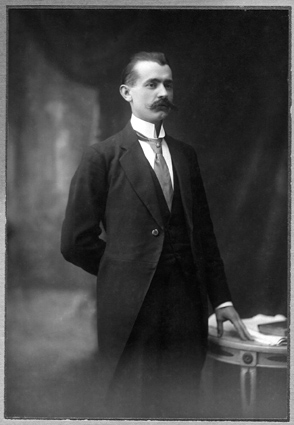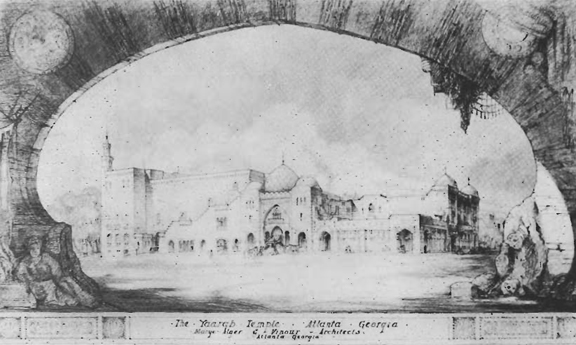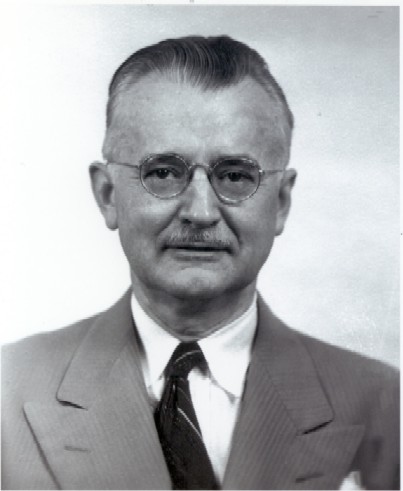
Ollivier J. Vinour
Web Master's note: Most of this information comes from a
letter to the Fox Theatre's Restoration Director, Rick Flinn from
Olliver Vinour's eldest daughter, Lydia in 1991.
Ollivier J. Vinour (he spelled his name this way to avoid being called
"Oliver") was born in Hauteford France, in the Dordogne
area, on March 19, 1889 and at an early age, the family
relocated to Paris. He was the second eldest in a family of four girls
and three boys. As a teenagers, he was educated at the Ecole Nationale
des Arts Decortatifs in Paris.
 In 1906, at the age of 17, he began working at an
architectural firm in Paris, presumably as a student apprentice. Vinour
entered into mandatory military service in 1911 as a reservist in the
"ler Compagne d'Aviation" In 1913, he was employed by an
"Architect dimplome du Gouvernment" and an "Architect des
Monuments Historiques" in Blois, LeHavre, and Angers. In 1914, he
married Marie-Louise Laurant. He saw active duty during the Great War
(now known as World War I). Due
to surgery (we do not know if this was war-related or not) he
was
furloughed in 1917, one year prior to the end of the war.
In 1906, at the age of 17, he began working at an
architectural firm in Paris, presumably as a student apprentice. Vinour
entered into mandatory military service in 1911 as a reservist in the
"ler Compagne d'Aviation" In 1913, he was employed by an
"Architect dimplome du Gouvernment" and an "Architect des
Monuments Historiques" in Blois, LeHavre, and Angers. In 1914, he
married Marie-Louise Laurant. He saw active duty during the Great War
(now known as World War I). Due
to surgery (we do not know if this was war-related or not) he
was
furloughed in 1917, one year prior to the end of the war.
After the war, he accepted a position in an architectural firm in
Detroit Michigan in 1919. This was done through the auspices of an
Americna Army officer he had met during the war. His wife and daughter
Lydia joined him in Detroit in 1920. In 1922, his resume
shows him working for an architect with offices in Miani and West Palm
Beach Florida. He resided in West Palm Beach for five years in a house
of his own design. During this period, Vinour and his family
became United States Citizens and Marie gave birth to his second
daughter.
In 1926 Olliver and his family settled in Atlanta Georgia and
became the minor partner of the Marye, Alger, and Vinour,
an architectural firm. It was during this period that he
entered an architecture contest to design the Yaarab Temple Atlanta
Shrine Mosque. Vinour designed a flamboyant interpretation of a mosque
with onion domes, towers, horseshoe and lancet arches, and minarets.
Amazingly, Vinour had never visited the Middle East and relied on books
and illustrations to influence and inspire his Mosque creation. It is
widely acknowledged that Mr Vinour was responsible for the majority of
the Mosque's design with minor input from P. Thornton Marye.
The presentation was so strong, nothing else compared to it and
Vinour's design was the clear winner.
 This illustration is Vinour's original
design for the Yaraab Temple Mosque. While it is readily identifiable
as what we now call "The Fox Theatre", it is a bit different from how
the building eventually came to be. This is the view looking at the
build from southern Peachtree Street looking north, over an open field
seeing the front of the building running alongside Kimball Street (now
Ponce DeLeon Ave). While slightly out of proportion, the building can
be divided into two sections. The right side, facing Peachtree Street
is the Mosque portion of the building. The left side, beginning under
the massive Onion Dome, is the auditorium portion of the structure.
This illustration is Vinour's original
design for the Yaraab Temple Mosque. While it is readily identifiable
as what we now call "The Fox Theatre", it is a bit different from how
the building eventually came to be. This is the view looking at the
build from southern Peachtree Street looking north, over an open field
seeing the front of the building running alongside Kimball Street (now
Ponce DeLeon Ave). While slightly out of proportion, the building can
be divided into two sections. The right side, facing Peachtree Street
is the Mosque portion of the building. The left side, beginning under
the massive Onion Dome, is the auditorium portion of the structure.
In an interview in the Atlanta Journal Magazine of February 16, 1930,
P. Thornton Marye elaborated on the inspirations for the design: "The
purpose was to retain the spirit of Islam throughout, and yet to use
all types of Mohammedan architecture that might be seen by a pilgrim on
his journey to Mecca, whether he came to the Holy City from the east,
north or south. Thus the arcade entrance with shops on either side was
designed after the fashion of a Persian bazaar." Although the building
is in no way a copy of any one Oriental structure it tries to embody
the entire scope of Mohammedan Art. The Mosque was designed to be
utterly incredible, unlike any other Shrine Mosque in the World!
During his association with Marye, Alger, and Vinour,
Vinour designed the Atlanta Railroad Terminal
Building, Atlanta City Hall, and the Southern Bell Headquarters among
other many notable and highly aclaimed buildings. In a touch of future
irony, Vinour was designing the Southern Bell Headquarters at the same
time he was working on the Shrine Moque project.
During the Great Depression, Vinour worked where he could find
employment, including a stint in Georgia Institute of Technology's
Architectural Department, working under Professor Harold Rush-Brown. He
worked there offering critiuqes of submitted architectural renderings.
He also worked for the US Army Public Building Procurement Division of
the U.S. Treasury Department, where he did work at Fort McPherson,
Washington D.C., and Philadelphia. He also worked with various
architectural and engineering firms that wokred on army bases in
Jacksonville, Florida, Meridian, Mississippi, and Augsuta, Georgia.
In 1945, Vinour relocated his family to Dallas, Texas where he was
associated with architect, George Dahl and later Mark Lemon &
Associates as an Associate.
 In 1951 he was on his way to Austin (about 175
miles south of Dallas) for an on-site planning session for the Student
Union Building at the University of Texas at Austin. They were hit
head-on by a car containing seven youths who had just left a roadside
bar. The driver was drunk and swerved into the wrong side of the road,
into Vinour's path with no time for Vinour to react. Olliver Vinour and
his associate were killed instantly. Vinour was 62 when he died.
In 1951 he was on his way to Austin (about 175
miles south of Dallas) for an on-site planning session for the Student
Union Building at the University of Texas at Austin. They were hit
head-on by a car containing seven youths who had just left a roadside
bar. The driver was drunk and swerved into the wrong side of the road,
into Vinour's path with no time for Vinour to react. Olliver Vinour and
his associate were killed instantly. Vinour was 62 when he died.
Lydia Vinour reflected on her memories of her "Papa". She wrote that
Ollivier was a huge film buff and loved to take his children to the
Saturday matinees and derived as much excitment from the serial
cliff-hangers as the children did. He was very gregarious and a
consumate Ham. He was always ready and eager to take part in any
amateur dramatic production that was put on by the various clubs he
belonged. He loved to play a court jester. Olliver loved
music and could pick out tunes on the piano. He could also play the
saxphone, the mandolin, and the violin. He was a lover of good food,
but when he was working on a project, he
would be so consumed by his work, he would forget to eat or what he did
eat.
While he was very generous to charities, he was a frugal man. Ludia
noted that he would carefully open mailed envelopes so they could be
flattened, the later used as scratch paper. He could be abscent-minded
at times. One of this constant characteristics that would drive his
wife to distraction was a habit of pocketing small napkins that were
distributed with refreshments at social functions. (Back then, the
napkins were cloth, so they were washed and reused. They were not meant
to be disposable!) Mrs. Vinour was always having to return napkins she
found in his coat pockets. It occurred so much, Ludia still claims to
have some of those stray napkins!
Vinour was very civic minded and belonged to many fraternal and social
orgainzations. He was a member of Atlanta's French Alliance, the Studio
Club, the Lion's Club, and during World War II, he helped establish
Atlanta headquarters for the Free French.
Most of all, Lydia remembers his tremendous curiousity and his habit of
being an ineterate student that was always taking courses to expand his
knowlege. Lydia remembers that his last fascination was the temples of
AnghorVat in Cambodia. He had complies several note books on the
subjest that were eventually lost in a family move.
.


 In 1906, at the age of 17, he began working at an
architectural firm in Paris, presumably as a student apprentice. Vinour
entered into mandatory military service in 1911 as a reservist in the
"ler Compagne d'Aviation" In 1913, he was employed by an
"Architect dimplome du Gouvernment" and an "Architect des
Monuments Historiques" in Blois, LeHavre, and Angers. In 1914, he
married Marie-Louise Laurant. He saw active duty during the Great War
(now known as World War I). Due
to surgery (we do not know if this was war-related or not) he
was
furloughed in 1917, one year prior to the end of the war.
In 1906, at the age of 17, he began working at an
architectural firm in Paris, presumably as a student apprentice. Vinour
entered into mandatory military service in 1911 as a reservist in the
"ler Compagne d'Aviation" In 1913, he was employed by an
"Architect dimplome du Gouvernment" and an "Architect des
Monuments Historiques" in Blois, LeHavre, and Angers. In 1914, he
married Marie-Louise Laurant. He saw active duty during the Great War
(now known as World War I). Due
to surgery (we do not know if this was war-related or not) he
was
furloughed in 1917, one year prior to the end of the war. This illustration is Vinour's original
design for the Yaraab Temple Mosque. While it is readily identifiable
as what we now call "The Fox Theatre", it is a bit different from how
the building eventually came to be. This is the view looking at the
build from southern Peachtree Street looking north, over an open field
seeing the front of the building running alongside Kimball Street (now
Ponce DeLeon Ave). While slightly out of proportion, the building can
be divided into two sections. The right side, facing Peachtree Street
is the Mosque portion of the building. The left side, beginning under
the massive Onion Dome, is the auditorium portion of the structure.
This illustration is Vinour's original
design for the Yaraab Temple Mosque. While it is readily identifiable
as what we now call "The Fox Theatre", it is a bit different from how
the building eventually came to be. This is the view looking at the
build from southern Peachtree Street looking north, over an open field
seeing the front of the building running alongside Kimball Street (now
Ponce DeLeon Ave). While slightly out of proportion, the building can
be divided into two sections. The right side, facing Peachtree Street
is the Mosque portion of the building. The left side, beginning under
the massive Onion Dome, is the auditorium portion of the structure.  In 1951 he was on his way to Austin (about 175
miles south of Dallas) for an on-site planning session for the Student
Union Building at the University of Texas at Austin. They were hit
head-on by a car containing seven youths who had just left a roadside
bar. The driver was drunk and swerved into the wrong side of the road,
into Vinour's path with no time for Vinour to react. Olliver Vinour and
his associate were killed instantly. Vinour was 62 when he died.
In 1951 he was on his way to Austin (about 175
miles south of Dallas) for an on-site planning session for the Student
Union Building at the University of Texas at Austin. They were hit
head-on by a car containing seven youths who had just left a roadside
bar. The driver was drunk and swerved into the wrong side of the road,
into Vinour's path with no time for Vinour to react. Olliver Vinour and
his associate were killed instantly. Vinour was 62 when he died.